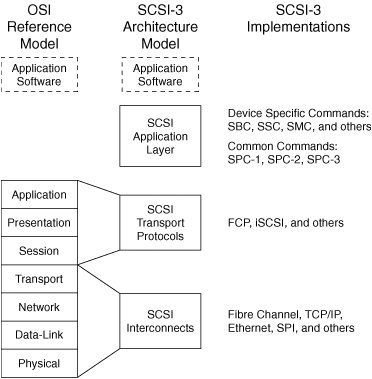SCSI Bus Interface and the ANSI T10 SCSI-3 Architecture Model
| In 1995, the ANSI T10 subcommittee published a three-layer architecture model for the transport of SCSI-3 traffic called the SCSI-3 architecture model (SAM). Two of the three layers are network-oriented, whereas the other is SCSI-oriented. The SAM generically groups all networking technologies into a layer called SCSI Interconnects. Likewise, all protocol mappings that enable SCSI-3 to be transported via SCSI Interconnects are grouped into a single layer called SCSI Transport Protocols. Consequently, the two SAM network layers do not map neatly to the OSI layers. Depending on the actual Interconnect used, the mapping to OSI layers can include one or more layers from the physical layer through the transport layer. Likewise, depending on the actual SCSI Transport Protocol used, the mapping to OSI layers can include one or more layers from the session layer through the application layer. As mentioned in Chapter 1, "Overview of Storage Networking," SCSI-3 is a command/response protocol used to control devices. This can be contrasted with communication protocols, which provide network functionality. Thus, the SCSI-3 command sets compose the third layer of the SAM, which resides above the other two layers. The SCSI-3 command sets are clients to the SCSI Transport Protocols. The SCSI Interconnect and SCSI transport layers are collectively referred to as the SCSI service delivery subsystem. The SCSI-3 command sets are collectively referred to as the SCSI application layer (SAL). The SCSI parallel bus interfaces are defined by the ANSI T10 subcommittee via the SCSI parallel interface (SPI) series of specifications. The SPI specifications are classified as Interconnects in the SAM. When using an SPI, SCSI commands are transmitted via the Interconnect without the use of a separate SCSI Transport Protocol. The interface between the SCSI command sets and the SPI is implemented as a procedure call similar to the interface between the SCSI command sets and SCSI Transport Protocols. Each variation of the SPI is a multidrop interface that uses multiple electrical signals carried on physically separate wires to control communication. Such control is normally accomplished via the header of a serialized frame or packet protocol. Some of the other SPI functions include signal generation, data encoding, physical node addressing, medium arbitration, frame generation, and frame error checking. Frame formats are defined for signals on the data wires, one of which contains a data field followed by an optional pad field followed by a cyclic redundancy check (CRC) field. So, the SPI essentially provides OSI physical layer functionality plus a subset of OSI data-link layer functionality. All devices connect directly to a single shared physical medium to create the multidrop bus, and interconnection of buses is not supported. So, there is no need for OSI data-link layer bridging functionality. The concept of OSI data-link layer connection-oriented communication is not applicable to non-bridged environments. Moreover, upper-layer protocol multiplexing is not required because only the SCSI command sets use the SPI. So, many of the services defined within the OSI data-link layer are not required by the SPI. Figure 2-3 compares the SAM to the OSI reference model, lists some specifications, and shows how the SPI specifications map to the OSI layers. Figure 2-3. SCSI Bus Relative to OSI |
EAN: 2147483647
Pages: 196
